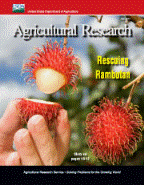United States Department of Agriculture: Agricultural Research Service, Lincoln, Nebraska

Agricultural Research Magazine
Date of this Version
1-2013
Document Type
Article
Citation
Agricultural Research January 2013.
Abstract
Growers battling a devastating citrus disease may soon benefit from a one-two punch from Florida researchers. Two Agricultural Research Service scientists at the U.S. Horticultural Research Laboratory in Fort Pierce are using two very different strategies to help citrus growers and processors deal with Huanglongbing (HLB), a disease that poses a major threat to the survival of the citrus industry and is costing it millions of dollars each year.
Elizabeth Baldwin, research leader of the Citrus and Subtropical Products Research Unit, is leading a team developing technology that orange juice processors can use to determine whether their product has the right taste. David Hall, research leader of the Subtropical Insects Research Unit, has found a way to better exploit a fungus that naturally controls HLB.
HLB, or citrus greening, was first detected in Florida in 2005 and is now established in all citrus-growing counties in the state. The disease was confirmed soon afterwards in backyard citrus trees in Georgia, Louisiana, and South Carolina. Citrus greening was recently confirmed in a commercial grove in Texas and in a single residential tree in California in 2012. A 2012 study by the University of Florida Institute of Food and Agricultural Sciences estimates that HLB has cost the state’s citrus industry $3.6 billion since 2006. The disease also occurs in tropical and subtropical Asia, India, Africa, and South America.
The presumed cause of HLB is the bacterium Candidatus Liberibacter asiaticus, and it is carried from plant to plant by the Asian citrus psyllid (Diaphorina citri), a tiny, winged insect that feeds on all citrus relatives. When a tree is infected, the bacterium moves into its phloem tissues, blocking the passage of nutrients through the vascular system until it makes the plant unproductive. Infected trees usually decline in productivity and die within 5 to 10 years of infection. Fruit on infected trees often falls to the ground before harvest, and those that remain on trees may become misshapen, sometimes only partially ripening in color. Juice from symptomatic fruit usually has an acidic, bitter taste.
Included in
Agriculture Commons, Animal Sciences Commons, Food Science Commons, Plant Sciences Commons

